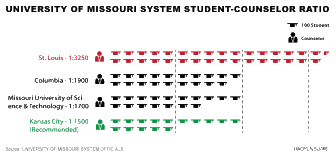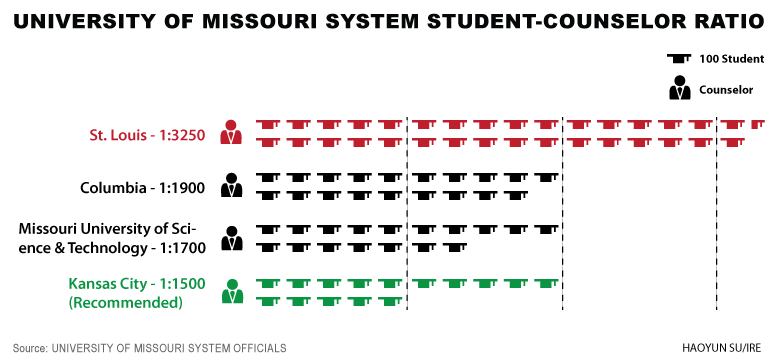In the aftermath of the April 2007 shooting at Virginia Tech, which left 33 people dead and 25 others wounded, Missouri’s Department of Homeland Security compiled a list of recommendations for universities to follow in order to decrease the likelihood of a similar attack occurring on a Missouri college campus.
Among the most important recommendations were calls for a higher percentage of counselors per student and for mental health counseling to be provided for students 24 hours a day, seven days a week.
However, four years later, The University of Missouri-Columbia and the University of Missouri system still have some glaring shortcomings in the counseling services provided to students:
- The International Association of Counseling Services (IACS) recommends schools have at least one counselor for every 1,500 students. MU’s Counseling Center provides a 2,600-to-1 ratio of professional counselors, and even if the Student Counseling Center is factored into the equation, the ratio is still 1,900 to 1. Only one campus in the UM system hits the recommended mark, and the St. Louis campus has more than 3,200 students for every counselor.
- Waiting lists for counseling services have decreased, but students still wait up to three weeks to get an appointment during the busiest times of the year.
- Demand is increasing at a rate that outpaces the school’s ability to provide services. At MU, the number of students seeking counseling has jumped more than 80 percent in five years. At the Kansas City campus, that number has jumped 175 percent in the past decade.
The International Association of Counseling Services (IACS) sets recommendations on the proper ratio of licensed mental health professionals per student. IACS recommends at least one counselor for every 1,500 students. Most schools come close, but do not actually meet this ratio.
Nationally, the student to counselor ratio has decreased from 1,700:1 to 1,600:1 over the past five years. However, with almost 34,000 students enrolled in MU and only 13 full-time (12 full-time plus 2 half-time) employees, each counselor is responsible for approximately 2,600 students, which is significantly above the national average.
When factoring in counselors who work in Student Mental Health rather than the MU Counseling Center, the ratio improves to 1,900 counselors per student, still well below the recommended threshold.
MU also has four psychological interns and six clinical graduate assistants, but these graduate students do not count toward the number of licensed counselors, according to Michael Mond, director of the Johns Hopkins University Counseling Center.
“One of the ideas behind the IACS recommendations is to prevent universities from just hiring graduate students to cut costs,” he said. “They shouldn’t be relied upon to do the work of experienced counselors.”
The situation was even more dire in 2009, just a year and a half after the shooting, when MU’s counseling center had their fewest number of full-time employees in a five year period, with only six licensed individuals on staff. 
Dr. Christy Hutton was one of those six employees.
Hutton, who is also the programming and communications coordinator for the center, said it was difficult to find qualified candidates who wanted to relocate to Mid-Missouri.
As a result, wait lists for students seeking mental health counseling swelled, and in the busiest times of the year, near mid-terms and final exams, they had to wait up to a month to see a therapist.
However, according to Hutton, the staff never shortened the duration of student appointments. “We find that anything less than a 50-minute session is ineffective,” she says.
The number of full-time licensed employees at the Counseling Center has steadily gone up in the past two years.
Hutton says this has decreased waiting lists for students to 2-3 weeks in the busiest parts of the year.
While MU fails to meet some of the most crucial benchmarks, the University of Missouri-St. Louis has an even more unfavorable ratio of 3,250:1, with only four licensed individuals for their 13,000 plus student.
The Missouri University of Science & Technology has 1,700 students per licensed individual, while only the University of Missouri-Kansas City meets the recommended ratio with eight psychologists, one social worker, and one psychiatrist for their 15,000 students.
Bill Burns isn’t surprised that some universities fail to meet ratios.
The chair of the Accreditation Board for IACS and the Counseling Center director at North Dakota State University says the size of a school’s counseling staff relative to the student population is important for minimizing waiting times for students, but missing out on recommended ratios alone does not prevent accreditation.
“These are just aspirational targets,” he says. “Not every school is going to meet them, but they should be in place so universities know what they should do.”
Increased Workload for Mental Health Counselors
According to Hutton, the number of students seeking treatment at MU has increased significantly in the past several years.
For the 2010-11 school year, 1,091 students sought individual, couples, or group therapy, an 81 percent increase from just five years ago.
It is not the only school in the University of Missouri system to experience significant increases in demand for mental counseling.
The University of Missouri-Kansas City experienced approximately a 175 percent increase in the number of students using the on-campus counseling center in the past decade.
And while Missouri University of Science & Technology has not had quite the same increased demand as the other two schools, they have already seen more than 400 students this year through the first 11 months, which is more than in any of the past three years.
The steady increases in the University of Missouri system fall in line with national numbers as well. According to a 2010 report by the National Survey of Counseling Center Directors (NSCCD), more than 10 percent of students at surveyed colleges sought on-campus counseling, a number which has continually risen over time.
Hutton says there are three main reasons why the number of college students seeking treatment has gone up. The most important factor is improved treatments for mental health disorders.
As more teenagers receive professional care for mental illness, an increasing percentage of them are able to pursue secondary education. In the past, this was not often possible for most students with mental disorders.
“If someone had a mental illness, college was not a feasible option,” she said. “They either received long-term treatment for their illness or they were placed in a closet and hidden from the rest of society.”
Now, it is possible for most students to juggle outpatient care and college coursework.
The second reason for increased rates of treatment is greater public understanding of mental illness.
As it has become less socially stigmatized, students have become willing to talk to others about their problems.
Therefore, students are less likely to internalize psychological issues, but an unintended consequence of greater openness and dialogue on mental health is an increased workload for psychologists, psychiatrists, and social workers.
However, mental illness has not lost its stigma equally across all demographics. According to the NSCCD survey, 65 percent of all students seeking counseling on college campuses are female.
At MU, Hutton says the gender disparity is even higher since females account for 70 percent of the counseling center’s clients.
“Men are not conditioned to ask for help,” Hutton says, “especially about mental illness.” And she believes that many of the most frequently used terms in counseling, including feelings, emotions, and therapy are off-putting to most male students.
In order to appeal to a larger number of male students, Hutton and others at the MU Counseling Center have begun outreach programs with fraternities and sought to hire a higher number of male psychologists.
“We still have underrepresented groups on campus, who are much less likely to come to the Counseling Center,” says Hutton, who identified African-Americans and international students as two other sets of students who were less likely to seek mental health treatment.
However, if the counseling center is successful in its attempts at making itself more accessible to under-represented students, there may be unintended problems. If more students seek counseling, then wait lists will grow.
The third reason for increases in student mental health issues is a decrease in mental health funding in private insurance policies.
While Hutton concedes this is not nearly as prominent as the first two factors, she says mental health care on college campuses, which rarely charges patients per appointment, is one of the last outlets for free (or highly discounted) treatment.
Dr. Patty Fleck, the director of the Counseling, Disability Support, and Student Wellness Center at Missouri S&T adds a fourth reason.
There are simply more students enrolled in college campuses these days. Even if the proportion of students seeking mental health treatment stayed the same, she says there would be a surplus of students to counselors.
MU has been able to meet part of the initial recommendation from the state’s Homeland Security office to provide students with 24 hour access to mental health treatment, for more than two decades.
The counseling center has partnered with Burrell Behavioral Health on a 1-800 line to provide after-hours care from licensed therapists to students in Columbia.
While Missouri S&T does not have the same 24-hour access, it is able to screen students within 24 to 48 hours of their first contact with the center to see if immediate care is necessary.
According to Fleck, if the initial screening is abnormal, students can be moved more quickly through the waiting lists, which can last up to two weeks in the busies periods in Rolla. Moreover, both universities provide at least 12 sessions of counseling free of charge (other than the Student Activity fees charged to all students), and MU has recently mandated 15 free sessions.
Fleck says students seeking help average four sessions in Rolla, and according to Hutton, students at MU average five to six sessions with counselors.
